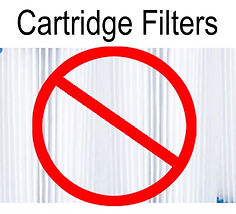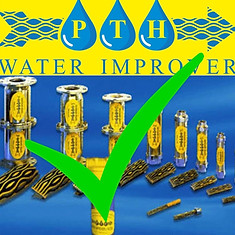

PTH
for your home
or small business
1mm of limescale build-up costs you
10% more in electricity fees!
Not to mention the cost of replacing geysers and other appliances because of limescale damage.
Why PTH is your best option for Domestic water treatment
There are many different water treatment systems available. These range from countertop units that get filled by hand to sophisticated – and expensive! – reverse osmosis (RO) systems.

There are critical issues to consider before deciding on a water improving system.


What about Cartridge filters?
Replacing filters and cleaning of units are required from between 2 months to 6 months or so.
Some types attach to your tap with the unit fitting under the counter, but essentially the same criteria apply.
PTH uses no filters that need to be replaced on a regular basis, so it’s more cost-effective.

Considering Reverse Osmosis?
Reverse Osmosis (RO) is conceivably the most expensive and most wasteful way of treating water known to modern man. It treats the water by pushing it through a membrane which removes all the solids, including essential minerals, from the water. The most popular RO system is the 5-stage. This gives you pure water with all impurities and minerals removed.
Although this might seem to be exactly what you want, there is one serious problem: our bodies, and especially those of growing kids, require those minerals for normal growth. We get those minerals from the water we drink, to be absorbed by the body.
The 6-stage RO system puts these minerals back into the water, while the 7-stage adds oxygen.
RO takes around one hour to create 7.5 litres of purified water, but in the process uses an additional 6 litres of water that simply run down the drain. If you use 7.5 litres a day for drinking, that would equate to a water wastage of 180 litres of water per month to get clean drinking water. No household in South Africa – or anywhere in the world, for that matter – can afford such waste.
PTH doesn’t waste water during the softening process and works faster. The PTH also doesn’t remove the essential minerals from the water.

Is a Resin Water Softener (Salt Water Softener) a viable option?
Hard water contains high levels of dissolved calcium, magnesium, and metals such as iron. The greater the amount of total dissolved minerals (TDS) in the water, the harder it is. Hard water causes lime-scale build-up in pipes and electrical elements heating water. It is also damaging to all household appliances like washing machines, dishwashers and air-conditioning systems.
A water softener is installed in the main water supply line to your home. There is a manual, semi-automatic and fully automatic system. It must be connected to the electricity supply.
The system needs periodic maintenance. The resin needs to be replaced. It also needs to be regenerated periodically with a brine rinse, at considerable cost.
Because of the many disadvantages associated with resin softeners – health risks, undrinkable water, polluting the soil with the brine rinse-off and others – resin softeners are increasingly being banned world-wide.
PTH softens your water without all the disadvantages associated with resin softeners.

The PTH system is a unit that is installed directly into the main water supply of your home. PTH units function without electricity supply, are easy to install and do not require costly maintenance.
PTH has a dual function, acting as both a descaler and water softener. This two-in-one combination results in a better tasting drinking water directly from your tap without removing the minerals necessary for your good health.
In addition, the system will also over time remove scale and rust from your water pipes and electrical elements, making everything last longer and saving you money.
With PTH-softened water at the turn of a tap, you will need to use less washing powder. When washing your car, those white marks left behind when the water dries can now simply be dusted off. Your garden and plants will thrive with better quality water.